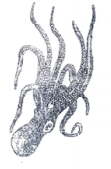The figure shows four animals (a), (b), (c) and (d). Select the correct answer with respect to a common characteristic of two of these animals:
| (a) |  |
(b) |  |
| (c) |  |
(d) |  |
1. (c) and (d) have a true coelom
2. (a) and (d) respire mainly through body wall
3. (b) and (c) show radial symmetry
4. (a) and (b) have cnidoblasts for self-defence
Match the following
| List-I | List-II | ||
| (a) | Physalia | i. | Pearl oyster |
| (b) | Limulus | ii. | Portuguese Man of War |
| (c) | Ancylostoma | iii. | Living fossil |
| (d) | Pinctada | iv. | Hookworm |
Choose the correct answer from the options given below:
| Options: | (a) | (b) | (c) | (d) |
| 1. | ii | iii | iv | i |
| 2. | i | iv | iii | ii |
| 3. | ii | iii | i | iv |
| 4. | iv | i | iii | ii |
| List I | List II | ||
| A. | Pleurobrachia | I. | Mollusca |
| B. | Radula | II. | Ctenophora |
| C. | Stomochord | III. | Osteichthyes |
| D. | Air bladder | IV. | Hemichordata |
Choose the correct answer from the options given below:
1. A-II, B-I, C-IV, D-III
2. A-II, B-IV, C-I, D-III
3. A-IV, B-III, C-II, D-I
4. A-IV, B-II, C-III, D-I
Match the following genera with their respective phylum :
| Column I | Column II | ||
| (a) | Ophiura | (i) | Mollusca |
| (b) | Physalia | (ii) | Platyhelminthes |
| (c) | Pinctada | (iii) | Echinodermata |
| (d) | Planaria | (iv) | Coelenterata |
Select the correct option :
| Options: | (a) | (b) | (c) | (d) |
| 1. | iv | i | iii | ii |
| 2. | iii | iv | i | ii |
| 3. | i | iii | iv | ii |
| 4. | iii | iv | ii | i |
| 1. | Arthropoda - The body is divided into a head, thorax, abdomen and respiration by mouth |
| 2. | Chordata - Notochord at some stage and separate anal and urinary openings to the outside |
| 3. | Echinodermata – Pentamerous radial symmetry and mostly internal fertilization |
| 4. | Mollusca - Normally oviparous and developed through a trochophore or veliger larva |
Match the following organism with their respective characteristics:
| Column I | Column II | ||
| (a) | Pila | (i) | Flame cells |
| (b) | Bombyx | (ii) | Comb plates |
| (c) | Pleurobrachia | (iii) | Radula |
| (d) | Taenia | (iv) | Malpighian tubules |
Select the correct option from the following:
| Options: | (a) | (b) | (c) | (d) |
| 1. | (iii) | (ii) | (iv) | (i) |
| 2. | (iii) | (ii) | (i) | (iv) |
| 3. | (iii) | (iv) | (ii) | (i) |
| 4. | (ii) | (iv) | (iii) | (i) |
In which one of the following, the genus name, its two characters and its phylum are not correctly matched, whereas the remaining three are correct?
| Genus Name | Two Characters | Phylum | ||
| 1. | Pila | (i) (ii) |
Body segmented Mouth with Radula |
Mollusca |
| 2. | Asterias | (i) (ii) |
Spiny skinned Water Vascular System |
Echinodermata |
| 3. | Sycon | (i) (ii) |
Pore bearing Canal system |
Porifera |
| 4. | Periplaneta | (i) (ii) |
Jointed appendages Chitinous exoskeleton |
Arthropoda |
Which one of the following is a matching set of a phylum and its three examples?
1. Cnidaria- Bonellia, Physalia, Aurelia
2. Platyhelminthes- Planaria, Schistosoma, Enterobius
3. Mollusca- Loligo, Teredo, Octopus
4. Porifera- Spongilla, Euplectella, Pennatula
Which one of the following pairs is mismatched?
| 1. | Pila globosa - pearl oyster | 2. | Apis indica- honey bee |
| 3. | Laccifer lacca- lac insect | 4. | Bombyx mori- silkworm |






